Screw fixation
1. General considerations
Introduction
A dorsal avulsion of the distal phalangeal base can be fixed with a screw if the proximal fragment is large enough and comprises more than half of the articular surface.

Lag screw vs position screw
Principally, the fracture should be fixed with a lag screw technique. In the metaphyseal parts of the phalanges, it is usually not advisable to drill a gliding hole through the small metaphyseal bone. A position screw holding a compression achieved with reduction forceps provides sufficient stability.
Operative treatment: caveat
Indications for surgical intervention are:
- Open fractures
- Palmar subluxation of the DIP joint

Surgical management of these fractures is difficult and has many potential complications. The soft tissues are only precariously vascularized, and the fragments are very small and prone to further comminution. Healing can often be slow.
2. Patient preparation
This procedure is usually performed with the patient in a supine position with the arm on a radiolucent side table.
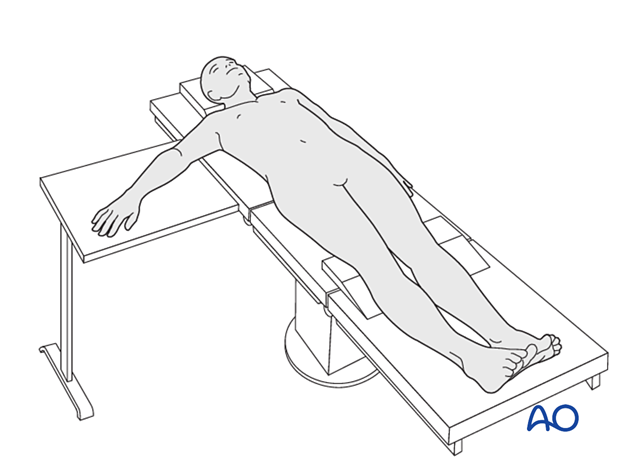
3. Approach
For this procedure, a dorsal approach to the DIP joint is typically used.
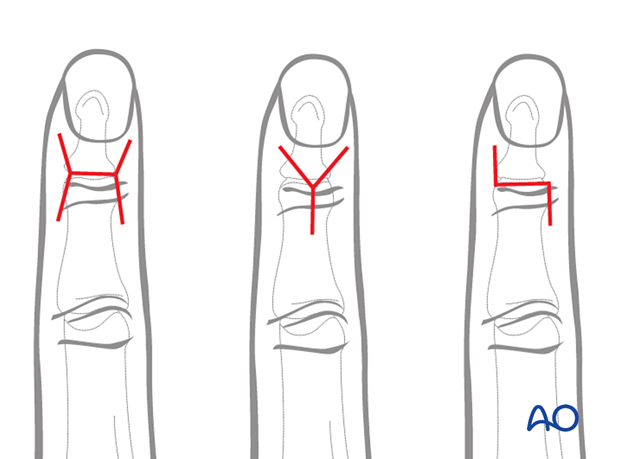
4. Reduction
Flex the DIP joint. To better visualize the fracture, use a syringe to clean out blood clots with a jet of water.
Often the degree of comminution is not apparent from the x-rays and can only be determined under direct vision.
Use a dental pick to carefully free interposed tissues and remove blood clots and other debris.
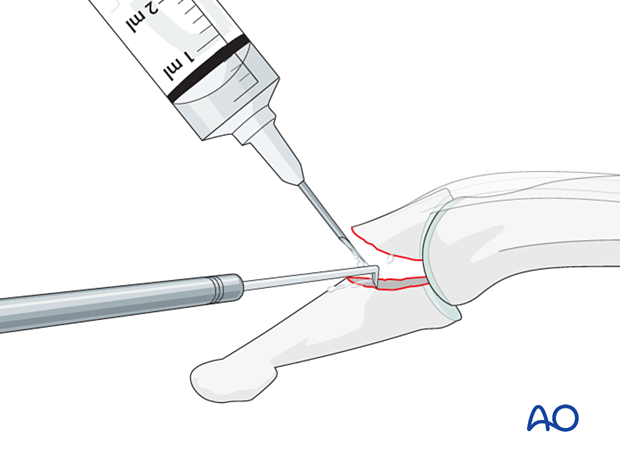
Extend the DIP joint. Reduce the fragment with percutaneous reduction forceps.

5. Fixation
Selecting screw size
The maximal permitted diameter of the screw head is one-third of the diameter of the avulsed fragment.
The screw length must be adequate for the screw to engage the opposite cortex.
Most commonly, a 1.0 mm diameter screw is used. 1.3 mm screws can also be used for large fragments.

Drilling
Drill a hole in both cortices.
Countersink the near cortex slightly to allow the screw head to sink almost flush with the cortical surface. This facilitates radial preload of the cortex to minimize the risk of secondary fracture and loosening of the screw. Be careful not to over-countersink the near cortex.
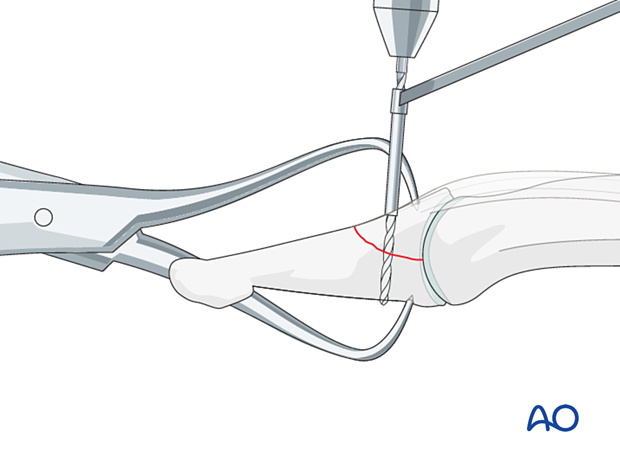
Determining the screw length
Use a depth gauge to determine the screw length.

Screw insertion
Insert a self-tapping screw and tighten it. The screw should engage the opposite cortex. Be careful not to overtighten the screw to avoid stripping the threads with subsequent loss of fixation.

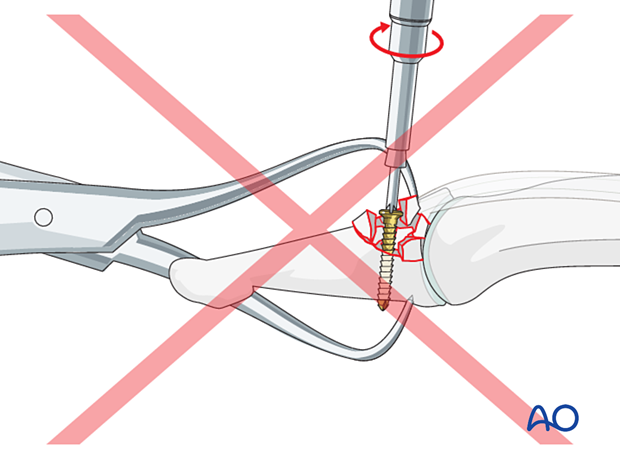
Final check
Confirm articular reduction and correct screw placement with an image intensifier. Reduction must be anatomical.

DIP joint transfixation
Palmar subluxation usually persists if the collateral ligament and the volar plate are ruptured.
In such a case, the DIP joint needs to be immobilized with a K-wire.
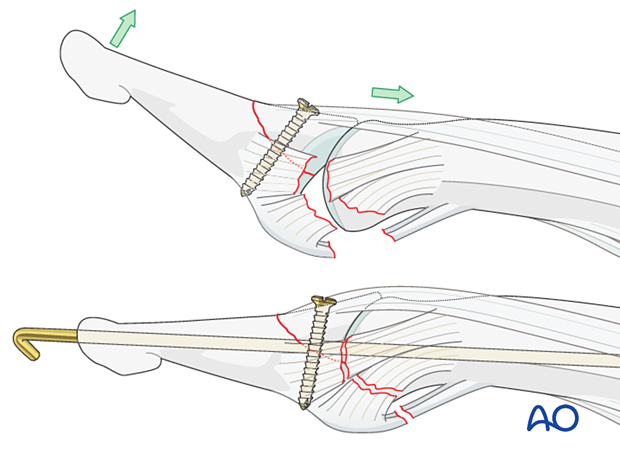
6. Immobilization
Immobilize the DIP joint in extension in a palmar splint, thermoplastic splint (not with K-wire transfixation), or buddy strapping, leaving the PIP joint free.
A Coban bandage to reduce swelling is recommended.
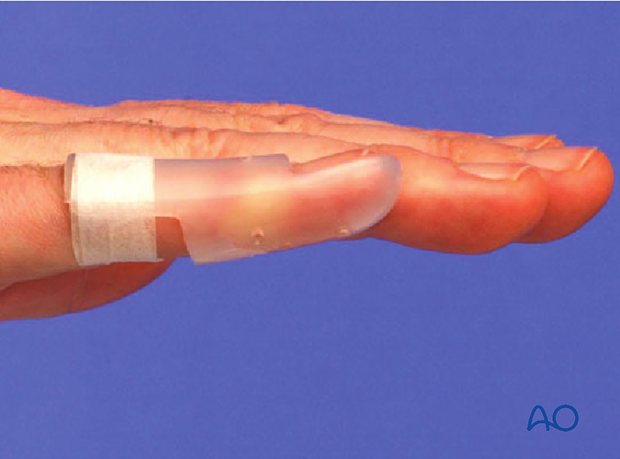
7. Aftercare
Postoperative phases
The aftercare can be divided into four phases of healing:
- Inflammatory phase (week 1–3)
- Early repair phase (week 4–6)
- Late repair and early tissue remodeling phase (week 7–12)
- Remodeling and reintegration phase (week 13 onwards)
Full details on each phase can be found here.
Management of swelling
The arm should be actively elevated to help reduce any swelling.
Mobilization
Mobilization depends on the stability gained by the fixation.
Hand therapy is recommended to prevent soft-tissue atrophy and joint contracture (typically extension of MCP joint and flexion of PIP joint), which leads to a poor outcome, and subsequent treatment is difficult.
PIP joint movement is encouraged immediately to avoid extensor tendon adhesion.
If the fixation is strong enough, the patient is encouraged to take off the splint 2–3 times daily and commence with gentle active exercises.
Follow-up
A wound check is performed 3–5 days after surgery. Dressings are changed to avoid the tourniquet effect of dried exudate or bleeding within the dressings.
Sutures may be removed after 10 days.
After 4 weeks, an x-ray is taken to confirm healing. Splinting can then usually be discontinued.
If, after 8 weeks, x-rays confirm healing and the patient is painless, full loading can be permitted.













